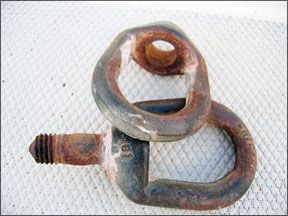My wife and I leave our boat moored in Bahia Coyote, Sea of Cortez, BCS Mexico. Our mooring is a system of anchors and chain that has worked well for us since 1987. Last year, I hired some friends to dive it. They replaced the chains and reported that everything else was in good shape.

Photo courtesy of David Kallgren
288
Days later, a neighbor noticed the boat drifting and rescued her. The cause: a swivel had failed. The swivel was in good shape, but the nut holding the halves together unscrewed.
I don’t use jaw/eye swivels because cotter pin-related failures are too common, and I don’t use Chinese swivels because the U.S.-made ones are more reliable. Have you heard of this happening?
David Kallgren,
Beagle, NorSea 27
Wyoming / BCS Mexico
Anchor swivels, as you noted, are a notorious weak point in a mooring system. Michael Muessel, of mooring installer Oldport Marine Services in Newport, R.I., said his company does not use swivels for that reason but he suggested that when used, swivels be placed between the top of the chain and the pendant and out of the water on top of the buoy, where they can be readily inspected.
Muessel said that in his professional opinion, the hot-galvanized Chicago Hardware (www.chicagohardware.com) swivel you used is the best available. It’s obvious the problem was not corrosion or wear. It would appear that the spot weld was inadequate. This highlights the necessity of closely inspecting mooring systems (including the welded nut on swivels) regularly.
Other things to remember when rigging a mooring: Do not use too much stainless seizing wire on shackles as it can cause electrolysis; don’t position a shackle where it will be bouncing on the bottom.
Bye, Bye Spidey
The sailing season is fast approaching in the upper Midwest, and with it, spider issues. The critters seem to walk the docklines onto the boat, where they crawl into the roller-reefed sails and tiller cover. I read that there is a spray that can be used on dock lines with good success. Have you done an evaluation?
Bob Satterfield,
Capri 22
Okee, Wisc.
We have not tested insecticides for spiders, primarily because we’ve never had a spider problem to test them against. Bugmaster Exterminators Inc. (www.bugmaster.com) in Mobile, Ala., suggested having a professional spray Bayer’s Temprid SC on docklines and pilings. This is a potent, toxic solution designed for professional use that we’d avoid applying near water, if possible. (We found it for DIYers at www.domyownpestcontrol.com.) For DIY treatments, Bugmaster recommended the all-natural and biodegradable EcoExempt IC2 concentrate or Dr. T’s Cobweb Eliminator. Both are widely available online.Practical Sailor FaceBook fan and boatowner Ann Romney suggested cleaning infested areas with a solution of water and the natural, phosphate- and chlorine-free 20 Mule Team Borax soap (www.20muleteamlaundry.com): “I find no evidence Borax harms fiberglass,” Romney said.
While the Temprid may be a more-potent punch, the natural insecticides are safer and would be our recommended route for DIY application. If you opt for the sure-thing Temprid, do yourself and the waterway a favor and have a pro do the treatment.




































